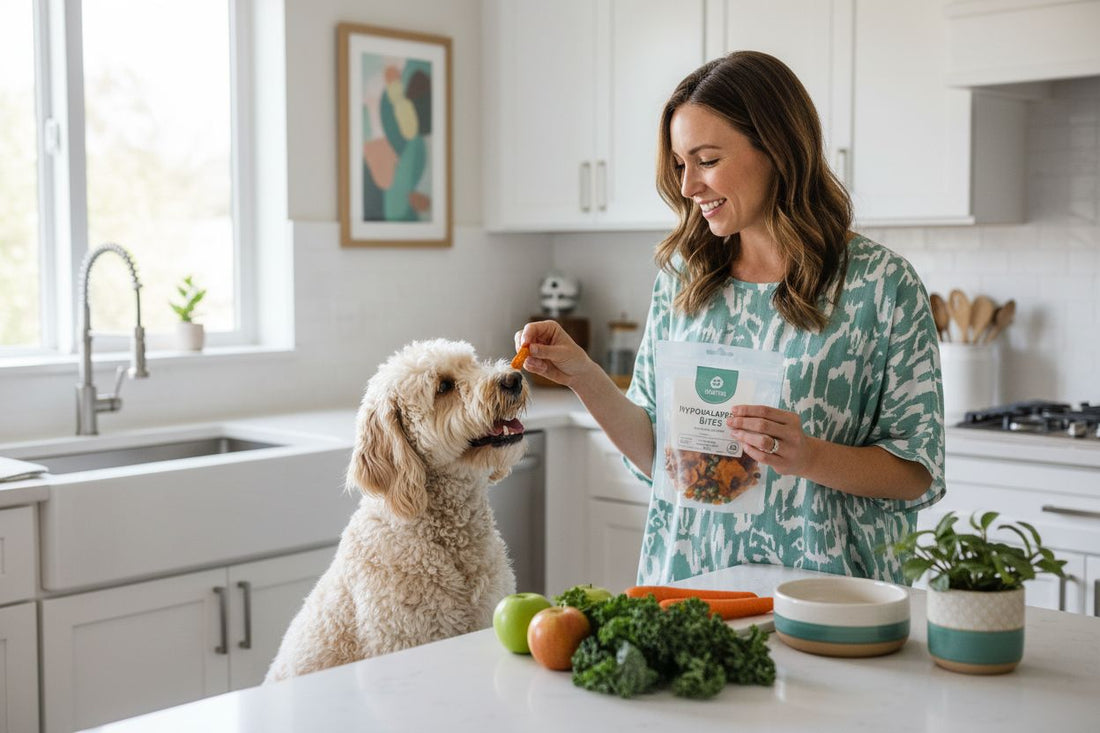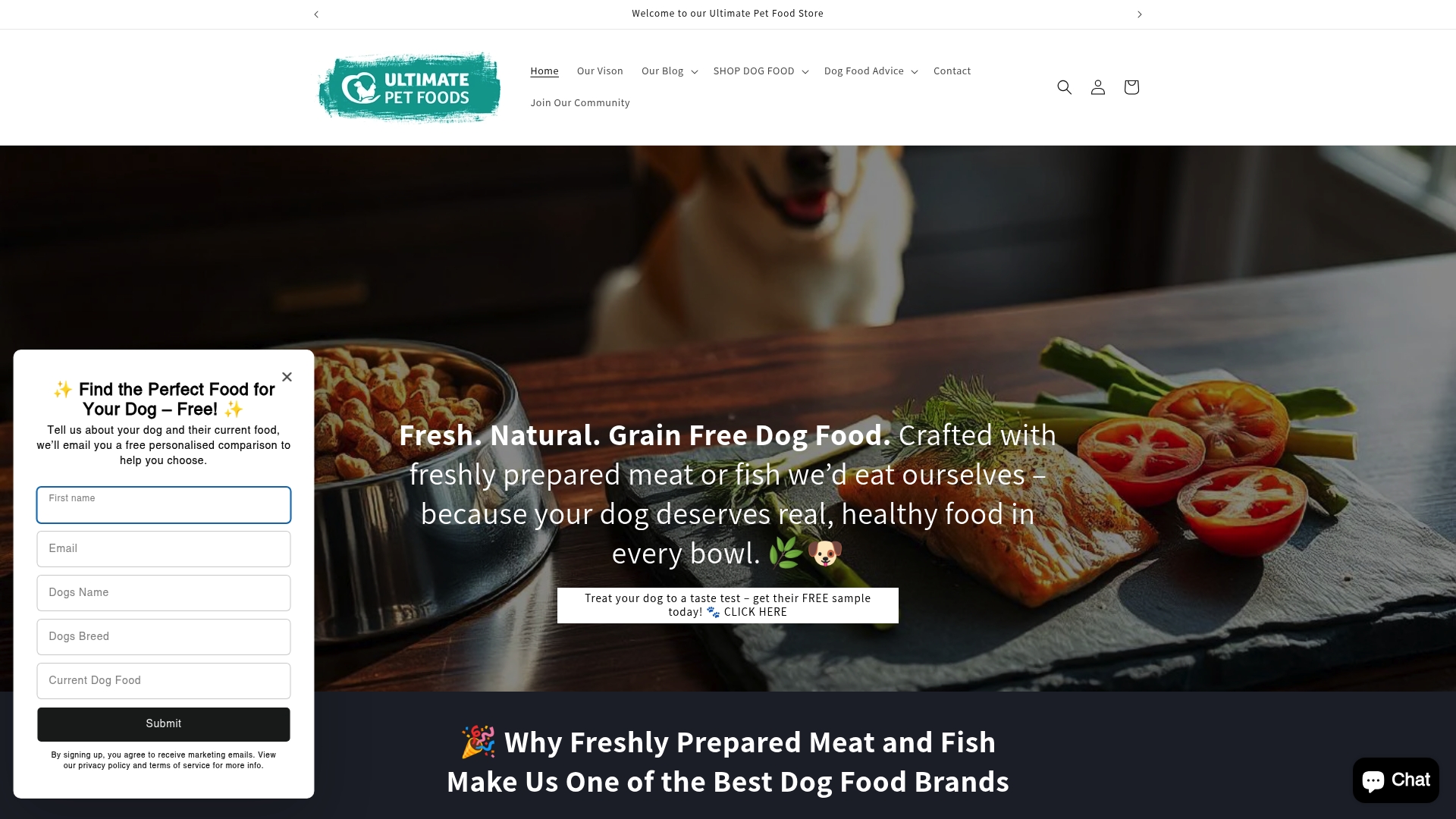
7 Best Hypoallergenic Dog Treats for Sensitive Pups
Share
Did you know that up to 20 percent of dogs suffer from food allergies or sensitivities? This can lead to persistent itching, digestive troubles, and a decline in your pup’s quality of life. With so many treat options available, choosing the right snacks becomes critical for dogs with delicate systems. Knowing how to select safe, natural treats gives your furry friend comfort while supporting overall health and happy mealtimes.
Table of Contents
- 1. Understanding Hypoallergenic Treats and Their Benefits
- 2. Key Ingredients to Look For in Natural Dog Treats
- 3. Avoiding Common Allergens in Dog Treats
- 4. Choosing Grain-Free Options for Sensitive Dogs
- 5. Breed-Specific Recommendations for Treat Selection
- 6. Supporting Skin and Coat Health With the Right Treats
- 7. How to Safely Introduce New Treats to Your Dog
Quick Summary
| Takeaway | Explanation |
|---|---|
| 1. Choose single protein sources for treats. | Single protein options like salmon and lamb reduce allergy risks for sensitive dogs. |
| 2. Avoid common allergens in treats. | Ingredients like wheat, dairy, and specific meat proteins can trigger allergic reactions in dogs. |
| 3. Introduce new treats gradually. | Start with small portions and monitor your dog for any allergic reactions before continuing. |
| 4. Opt for grain-free options if needed. | Grain-free treats support better digestion and are ideal for dogs with sensitivities to grains. |
| 5. Consult your veterinarian for tailored advice. | Your vet can help identify allergens and recommend the best hypoallergenic options for your dog’s needs. |
1. Understanding Hypoallergenic Treats and Their Benefits
Hypoallergenic dog treats are specially formulated nutrition options designed for pups with sensitive digestive systems and food allergies. These treats go beyond standard snacks by minimising ingredients that typically trigger adverse reactions in dogs.
When a dog experiences food sensitivities, their immune system overreacts to specific protein sources or additives. Hypoallergenic treats work by eliminating common allergens and using gentle, easily digestible ingredients that reduce inflammation and support overall canine health. Our freshly prepared meat options are gently cooked at 82°C to preserve nutrients while ensuring maximum digestibility.
These specialised treats typically feature:
- Single protein sources
- Limited ingredient formulations
- Grain free options
- Hydrolysed proteins that are broken down into smaller peptides
For pet owners navigating food sensitivities, hypoallergenic treats provide a safe solution. They help prevent uncomfortable symptoms like skin irritations, digestive issues, and chronic ear infections. Understanding dog food for allergies becomes crucial in managing your dog’s nutritional wellness.
Before introducing any new treats, consulting with your veterinarian can help identify specific allergies and recommend the most suitable hypoallergenic options for your furry friend’s unique dietary needs.
2. Key Ingredients to Look For in Natural Dog Treats
Choosing the right ingredients for hypoallergenic dog treats requires careful consideration of your pup’s nutritional needs and potential sensitivities. Natural treats should support your dog’s health while avoiding common allergens that might trigger adverse reactions.
High Quality Protein Sources are fundamental in creating effective hypoallergenic treats. Look for single protein options like salmon, lamb, or duck that are less likely to cause allergic responses. These proteins provide essential amino acids and support muscle development.
Key ingredients to prioritise include:
- Salmon protein: Rich in omega 3 fatty acids
- Peas: Easily digestible carbohydrate source
- Linseed oil: Supports skin and coat health
- Hydrolysed proteins: Broken down for easier digestion
Our freshly prepared meat treats are gentle cooked at 82°C to preserve nutrients and ensure maximum digestibility. The process helps break down proteins into more manageable components that reduce potential allergic triggers.
Understanding natural dog food ingredients can help you make informed choices about what goes into your dog’s treats. When selecting treats, avoid common allergens like wheat, soy, and artificial preservatives that might compromise your dog’s digestive health.
Remember that every dog is unique. Monitoring your pet’s response to new treats and consulting with your veterinarian can help you develop the most appropriate nutrition strategy for your sensitive pup.
3. Avoiding Common Allergens in Dog Treats
Understanding and identifying potential allergens in dog treats is crucial for maintaining your sensitive pup’s health and preventing uncomfortable allergic reactions. Not all ingredients are created equal when it comes to canine nutrition.
Common allergens in dog treats can trigger various health issues ranging from mild skin irritations to severe digestive problems. Pet owners should be vigilant about recognising ingredients that might cause adverse reactions in their furry companions.
Key allergens to watch out for include:
- Wheat and gluten
- Dairy products
- Soy protein
- Artificial preservatives
- Specific meat proteins like beef or chicken
Our freshly prepared treats are carefully formulated to minimise potential allergens. We gently cook our ingredients at 82°C to preserve nutrients while creating easily digestible options that support your dog’s overall wellness.
Protein sources often play a significant role in triggering allergies. Some dogs might react differently to specific animal proteins. This means what causes an allergic response in one dog might be perfectly safe for another. What ingredients to avoid in dog food can provide additional insights into making safer nutritional choices.
If you suspect your dog has food sensitivities, consider working with your veterinarian to conduct an elimination diet. This process helps identify specific triggers and allows you to select treats that support your dog’s unique dietary requirements.
4. Choosing Grain-Free Options for Sensitive Dogs
Grain-free dog treats offer a specialised nutrition solution for pups with sensitive digestive systems or specific dietary requirements. These treats eliminate common grain ingredients that might trigger allergic responses or digestive discomfort in some dogs.
Why Grain-Free Matters for sensitive dogs involves understanding how certain cereal ingredients can cause inflammatory reactions. Grains like wheat, barley, and rye contain proteins that some dogs struggle to process efficiently. By removing these potential irritants, grain-free treats support better digestive health and overall wellness.
Key benefits of grain-free treats include:
- Reduced digestive inflammation
- Lower risk of food sensitivity reactions
- Improved nutrient absorption
- Support for dogs with specific dietary needs
Our freshly prepared treats are gently cooked at 82°C to preserve nutrients and create easily digestible options. We specifically focus on alternative carbohydrate sources like peas and sweet potatoes that provide energy without causing potential allergic responses.
Understanding the benefits of grain free diet can help pet owners make informed decisions about their dog’s nutrition. When selecting grain-free treats, look for options that replace grains with nutrient-dense alternatives like legumes, vegetables, and high-quality proteins.
Remember that every dog is unique. What works perfectly for one pup might not suit another. Consulting with your veterinarian can help you develop the most appropriate nutrition strategy for your sensitive companion.
5. Breed-Specific Recommendations for Treat Selection
Selecting the right treats for your dog involves more than just finding a tasty snack. Different dog breeds have unique nutritional requirements and sensitivities that demand tailored treat options to support their specific health needs.
Size and metabolism play crucial roles in determining appropriate treat selections. Smaller breeds like Chihuahuas and Yorkshire Terriers require smaller portions with concentrated nutrients, while larger breeds such as Labrador Retrievers and German Shepherds need treats that support their higher energy levels and muscle maintenance.
Consider these breed specific treat recommendations:
- Small Breeds: Smaller protein dense treats
- Medium Breeds: Balanced protein and carbohydrate treats
- Large Breeds: Treats supporting joint health
- Working Breeds: High energy nutrient rich options
Our freshly prepared treats are gently cooked at 82°C to preserve nutrients and create easily digestible options suitable for various breed requirements. We focus on creating versatile treats that accommodate different dietary needs.
Understanding the best dog food for sensitive dogs can provide additional insights into breed specific nutritional considerations. Each dog is unique and consulting with your veterinarian remains the most reliable method for determining ideal treat selections.
Remember that individual dog health history matters more than broad breed generalisations. Factors like age, activity level, and existing health conditions should always guide your treat selection strategy.
6. Supporting Skin and Coat Health with the Right Treats
Healthy skin and a lustrous coat are powerful indicators of your dog’s overall nutritional wellness. The right treats can play a significant role in supporting your pup’s external health by delivering essential nutrients directly through their snacking routine.
Nutritional building blocks for skin and coat health focus on specific omega fatty acids, proteins, and key minerals. These components work synergistically to promote skin elasticity, reduce inflammation, and encourage a shiny coat that reflects your dog’s inner vitality.
Key nutrients for optimal skin and coat support include:
- Omega 3 fatty acids
- Linseed oil
- High quality protein sources
- Zinc and vitamin E
- Antioxidant rich ingredients
Our freshly prepared treats are gently cooked at 82°C to preserve nutrients and ensure maximum absorption. We specifically incorporate ingredients like linseed oil and carefully selected proteins to support dermatological health from the inside out.
Understanding dog food for skin issues can provide additional insights into comprehensive skin wellness strategies. Consistent nutrition remains the cornerstone of maintaining your dog’s external health and addressing potential underlying sensitivities.
Remember that every dog is unique. While treats can support skin health, persistent skin problems require professional veterinary consultation to identify and address potential underlying conditions.
7. How to Safely Introduce New Treats to Your Dog
Introducing new treats to your sensitive pup requires a thoughtful and gradual approach. Rushing this process can lead to digestive upset or allergic reactions that might cause unnecessary stress for both you and your furry friend.
Careful introduction strategies are essential when exploring hypoallergenic treats. The key is to approach treat testing like a scientific experiment where you monitor your dog’s response and watch for any potential adverse reactions.
Recommended steps for safe treat introduction include:
- Start with tiny portions
- Introduce one new treat at a time
- Wait 48 to 72 hours between new treats
- Observe for any digestive or skin reactions
- Keep a food reaction journal
Our freshly prepared treats are gently cooked at 82°C to preserve nutrients and create easily digestible options. We recommend beginning with small bite sized pieces to help your dog adjust and minimise potential digestive complications.
Expert tips for transitioning dog foods can provide additional guidance on managing dietary changes. Always prioritise your dog’s individual health needs and be prepared to discontinue a treat if any negative symptoms emerge.
Remember that every dog is unique. What works perfectly for one pup might not suit another, so patience and careful observation are your best tools in finding the ideal hypoallergenic treats.
Below is a comprehensive table summarizing the key aspects of hypoallergenic dog treats and their benefits discussed throughout the article.
| Topic | Description | Key Considerations |
|---|---|---|
| Hypoallergenic Treats | Specially formulated to minimise allergens and improve digestion. | Use single proteins, limited ingredients, grain-free options. |
| Key Ingredients | High-quality proteins, omega 3 fatty acids, linseed oil. | Avoid common allergens like wheat and soy. |
| Grain-Free Options | Eliminates grains to reduce inflammation and support digestion. | Replace grains with peas and sweet potatoes. |
| Breed-Specific Nutritional Needs | Varies with size and metabolism requirements. | Small breeds need concentrated nutrients; large breeds need joint support. |
| Skin and Coat Health | Supported by omega fatty acids, linseed oil, and antioxidants. | Monitor for nutrient absorption and any adverse reactions. |
| Introducing New Treats | Introduce slowly to avoid digestive upset. | Start with small portions and monitor reactions. |
Find the Perfect Hypoallergenic Treat for Your Sensitive Dog Today
Managing your dog’s food sensitivities can feel overwhelming, especially when finding treats that support their unique nutritional needs without causing allergic reactions. This article highlights common challenges such as avoiding hidden allergens, choosing grain-free options, and the importance of introducing new treats carefully. You want treats with limited ingredients, single protein sources, and natural goodness that enhance your dog’s wellbeing and keep their skin and coat healthy.

Explore our Dog Treats - Healthy & Natural with Functional Benefits – Ultimate Pet Foods for carefully crafted, grain-free, hypoallergenic treats that have been gently cooked to preserve nutrients and improve digestibility. Each product caters to sensitive pups and various breed-specific needs. Don’t wait to give your dog a treat that truly supports their health and happiness. Visit https://ultimatepetfoods.co.uk now to find natural, premium options designed to keep your best friend comfortable and thriving. For a broader look at our specialised products, check out our collections – Ultimate Pet Foods and discover blends even suitable for senior dogs in Blends for our Senior Dogs – Ultimate Pet Foods.
Frequently Asked Questions
What are hypoallergenic dog treats?
Hypoallergenic dog treats are specially formulated snacks designed for dogs with food sensitivities and allergies. They contain limited ingredients to minimize potential allergens and support overall canine health.
How can I identify if my dog needs hypoallergenic treats?
Watch for signs like skin irritations, digestive issues, or ear infections. If you notice these symptoms, consider consulting a veterinarian to identify specific allergens and discuss the introduction of hypoallergenic treats.
What ingredients should I look for in hypoallergenic dog treats?
Focus on high-quality protein sources such as salmon or lamb, and avoid common allergens like wheat and soy. Opt for treats made with hydrolyzed proteins for easier digestion and fewer allergic reactions.
How do I introduce new hypoallergenic treats to my dog safely?
Start by giving your dog a tiny portion of the new treat. Wait for 48 to 72 hours to watch for any adverse reactions before introducing another new treat, ensuring a careful transition.
Can hypoallergenic treats help with my dog’s skin and coat health?
Yes, hypoallergenic treats containing omega fatty acids and high-quality proteins can improve your dog’s skin and coat health. Incorporate these treats into your dog’s diet consistently to see noticeable changes over time.
Are grain-free treats essential for all dogs with sensitivities?
Not all dogs with sensitivities need grain-free treats, but they can benefit those with specific dietary reactions to grains. Assess your dog’s individual needs and consider choosing grain-free options if you suspect grains may contribute to your dog’s discomfort.
